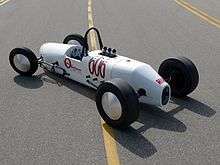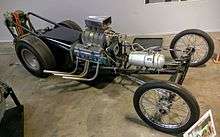Dragster (car)
A dragster is a specialized competition automobile used in drag racing.
Dragsters, also commonly called "diggers", can be broadly placed in three categories, based on the fuel they use: Gas (gasoline), Alcohol (methanol), and Fuel (a mixture of gasoline and nitromethane). They are most commonly single-engined, though twin-engined designs did race in the 1950s and 1960s.
The design of dragsters evolved from the front-engined rail (named for the exposed frame rails) of the earliest days of drag racing, into the "slingshot" (with the driver between or behind the rear tires, or "slicks") of the early to middle 1960s, to the "modern" type common in the 1970s.
History
Front engine
The front engine dragster came about due to engines initially being located in the car's frame in front of the driver. The driver sits angled backward, over the top of the differential in a cockpit situated between the two rear tires, a design originating with Mickey Thompson in 1954, as a way of improving traction.[1] This position led to many drivers being maimed when catastrophic clutch failures occurred.[2] Due to limited traction, some dragsters with four rear drive wheels were attempted[3] as well as designs with twin engines.[3]
Rear engine
The drawbacks of front-engine designs (including fatalities) led to several attempts at rear-engined cars. On March 8, 1970, at Lions Drag Strip,[4] "Big Daddy" Don Garlits was driving Swamp Rat XIII, also called the Wynnscharger, a slingshot rail, when the vehicle suffered a catastrophic failure, and the car broke in half in front of the cockpit.[5]
Garlits' accident was like many in the 1960s, and his new design followed several other pioneer designs of rear-engined dragsters (and funny cars, including Doug Thorley's and Dave Bowman’s[6]), among them Steve Swaja's AA/Gas Wedge I from 1963, Roger Lindwall's 1966 Top Fuel Re-Entry, and Dave Miller's Drag Wedge (for Andy Granatelli, sponsored by STP) and Kent Fuller's fueller Sidewinder III, both in 1969.[7][8]
The rear-engine design proved its worth in 1970, when Dwayne Ong's Glmore-chassised Pawnbroker won the American Hot Rod Association Summernats in Long Island, New York, the first national event win for a rear-engined car, with a pass of 6.83 at 219 mph (352 km/h).[9]
Garlits returned to Pomona with a brand new mid-engined car, Swamp Rat XIV, in 1971.[10] At first, the rodding magazines considered the disadvantages of the new design "obvious". Swamp Rat XIV, however, was so successful in 1971, Garlits won two of his next three Top Fuel Eliminator titles (the Winternats and Bakersfield), and was runner-up at Lions, all in the new car.[11]
Rear engine dragsters have since become the standard dragster design.[12]
Depending on the class they run in, dragsters can be injected or supercharged (or turbocharged), with a variety of possible engines. The engines are most often derived from automobiles'; some early examples used surplus aircraft engines. Today, they may also be electric.
Dragsters are distinct from "bodied" cars such as funny cars and gassers, as well as from altereds.
Historic cars
- 1954 — first slingshot, built by Mickey Thompson.[13]
 Smokin' White Owl built by George "Ollie" Morris in 1954
Smokin' White Owl built by George "Ollie" Morris in 1954 - 1954 — Smokin' White Owl, built by George "Ollie" Morris, first purpose-built rear-engined dragster and first car to use a Chevrolet V8 engine.[14][15]
- 1962 — the Greer-Black–Prudhomme digger, with the best win record in NHRA history.[16]
- 1971 — Swamp Rat XIV (or Swamp Rat 1-R), first successful rear-engined dragster, built by Don Garlits;[17] Ed Donovan introduces the 417 Donovan hemi, an aluminum copy of the Chrysler[18]
Notes
- ↑ Hot Rod. Dec 1986. p. 29. Missing or empty
|title=(help) - ↑ Levy, Art (2012-10-03). "Florida Icon: Don 'Big Daddy' Garlits". Florida Trend. Retrieved 2014-03-21.
- 1 2 Hot Rod. Jul 1990. p. 143. Missing or empty
|title=(help) - ↑ NHRA.com (retrieved 24 May 2017
- ↑ NHRA.com photo (retrieved 24 May 2017)
- ↑ "Gallery: The Best of 1970s Drag Racing", written by Dave Kommel on April 25, 2017, at Hot Rod online (retrieved 22 May 2017)
- ↑ Taylor, Thom. "Tony Nancy Gas Dragster", "Roger Lindwall Re-Entry", and "Kent Fuller Sidewinder III", in "Beauty Beyond the Twilight Zone", pp.34, 38, and 42.
- ↑ NHRA.com (retrieved 24 May 2017)
- ↑ Hot Rod staff writers. "The History Of Hot Rodding – 1970s", written 29 August 2013, at Hot Rod Network (retrieved 19 June 2017)
- ↑ Hot Rod. Dec 1986. p. 28. Missing or empty
|title=(help) - ↑ Hot Rod. Dec 1986. p. 28. Missing or empty
|title=(help) - ↑ Street Thunder Flashback: "Big Daddy" and his "Swamp Rat XIV"
- ↑ "Smokin' White Owl". Hot Rod. November 1954.
- ↑ Post, Robert C. (2001). High Performance The Culture and Technology of Drag Racing 1950-2000. Baltimore, Maryland: Johns Hopkins University Press. p. 38. ISBN 0-8018-6664-2.
- ↑ Hot Rod, 12/86, p.29 sidebar
- ↑ Hot Rod, 12/86, p.28.
- ↑ Street Rodder, 7/94, p.144.
Source
- Taylor, Thom. "Beyond the Twilight Zone" in Hot Rod Magazine, April 2017, pp.30-43.
- Hot Rod, 12/86, p.29 sidebar
